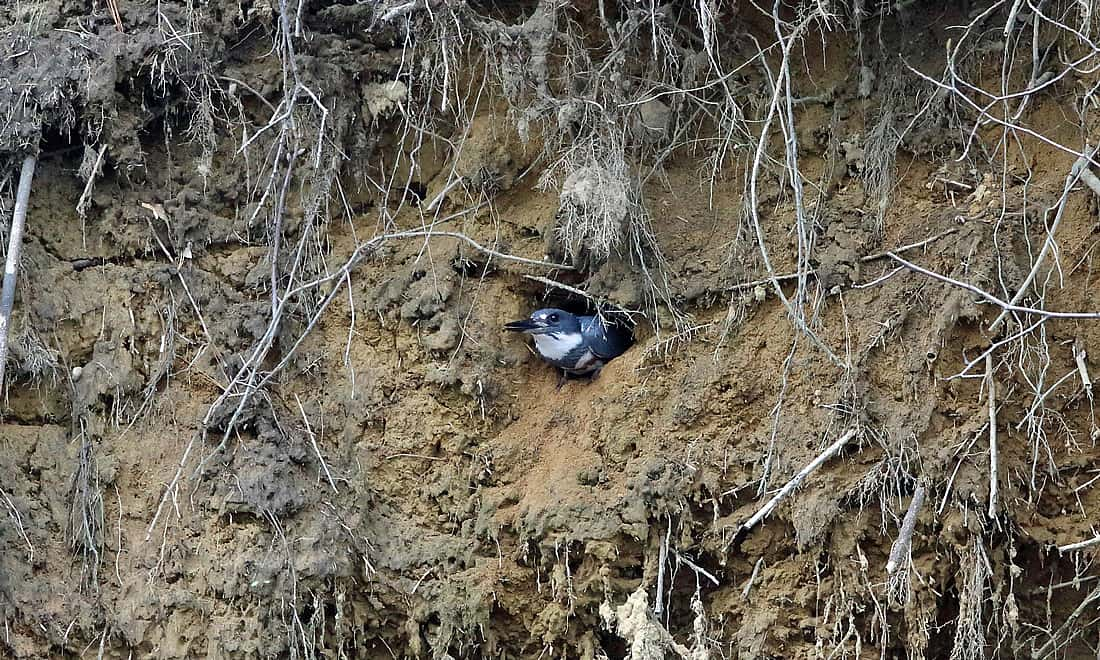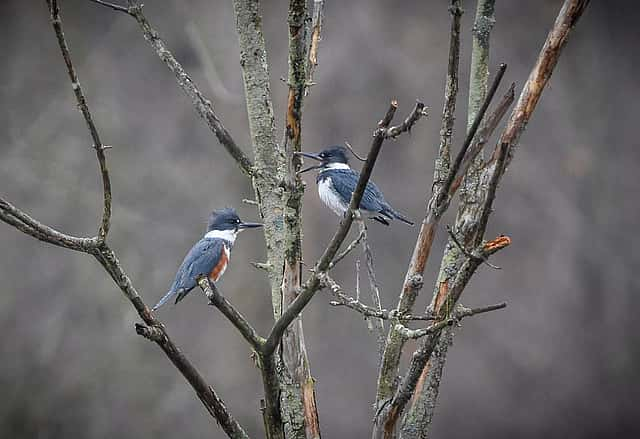
Belted Kingfisher: A Water Dependent Bird
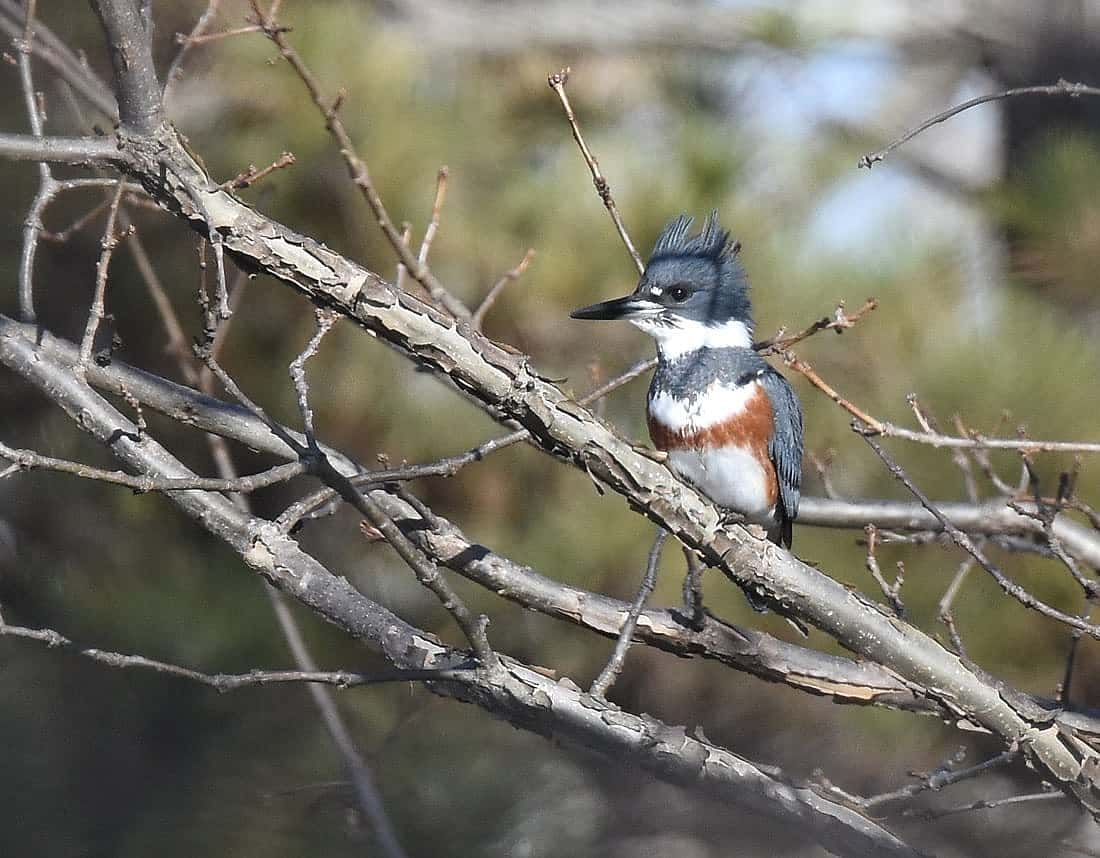
If you have ever seen a Belted Kingfisher (Megaceryle alcyon) it is probably around water. Water may even influence migration patterns, as Kingfishers that do not migrate remain only if open water is available year long.
Kingfishers, though not all, may make long-distant migrations. These migrations may span from northern Alaska and Canada as far south as Mexico, Central America, and even into northern parts of Venezuela and Colombia. Interestingly, for populations that migrate, females seem to travel longer distances than males.
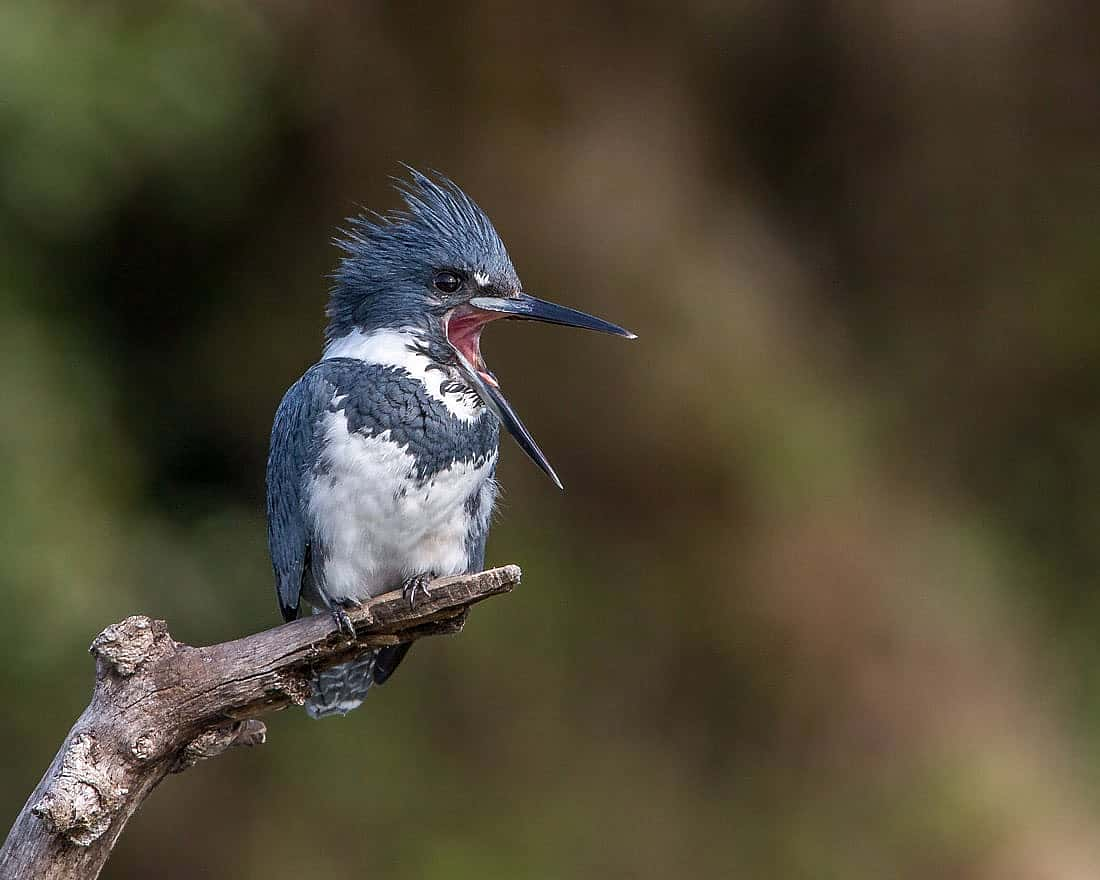
Why is the Appearance of Belted Kingfishers Unusual?
For birds world wide it is typical for males and females to either look alike or for males to dress in fancier, more colorful plumage.
In contrast to this, Belted Kingfishers are one of the few species in which the female is more brightly colored than the male. If seen from the front or side a positive sex ID is easy to make. Both sexes have a crest and a powdery blue-gray back. The males carry one blue band across their white breast. On the other hand females carry two bands. One blue and other chestnut. Go back and take a look at the opening photo. Noting the bands, is it a female or male? If you said female, you are correct. The males do not sport a chestnut color.
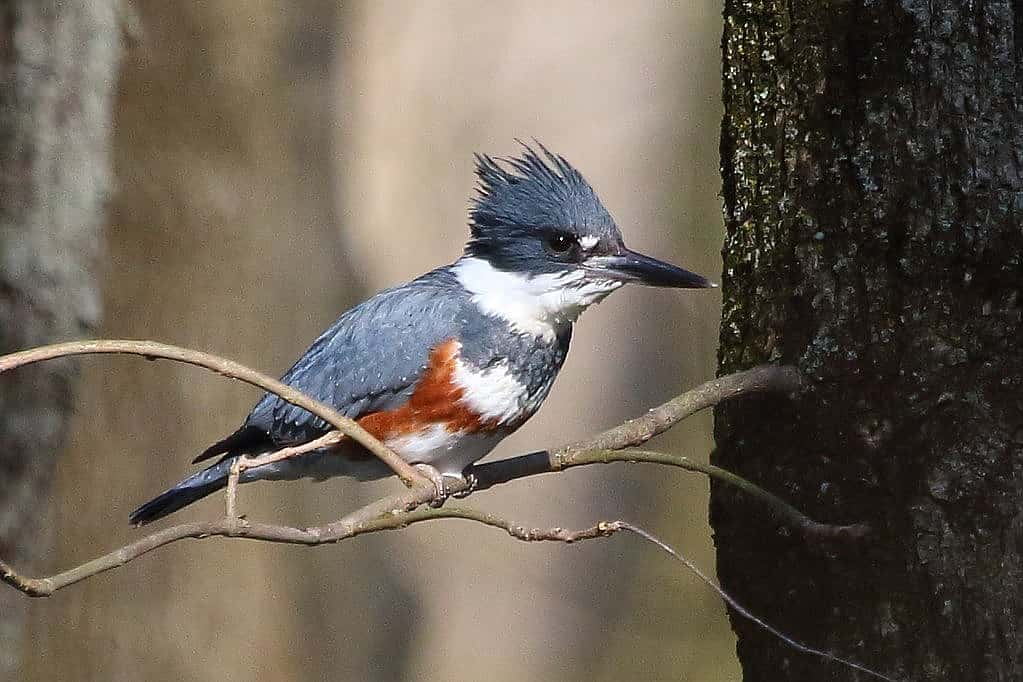
Why Do Female Belted Kingfishers Have an Extra Band?
According to Cornell’s All About Birds there is no scientific absolute answer. However, there are a couple of hypotheses about this unusual color adaptation. It’s a wide belief that most features of a species develop because of some type of an advantage it gives them to their lifestyle.
In the 1970s a study suggest that the color differences in the plumage may help males recognize females. Their migration habits may affect this. These birds are highly territorial, therefore sometimes the males reside in their territories year-round in order to protect their established breeding area. On the other hand, the females may migrate south for the winter.
The males begin to defend their territories before the females return. When they see a flicker of a rusty belt, this signals the male that a female is present. This color adaptation therefore alerts him to not chase her off.
On the other hand, other scientists say that not all differences in nature are explained by adaptations. They argue that some features are the result of the development of other features, rather than for any specific reason of their own. As an example, during breeding season, the female kingfisher is generally the more aggressive and territorial bird when compared to males. This may mean that females have a higher testosterone level that may in turn affect the way pigments develop in a bird’s plumage.
The necessary studies to determine if or which of these hypotheses are true still needs to be done. As Cornell states, “It’s a good example of how scientific questions are all around us, waiting for curious people to investigate.”
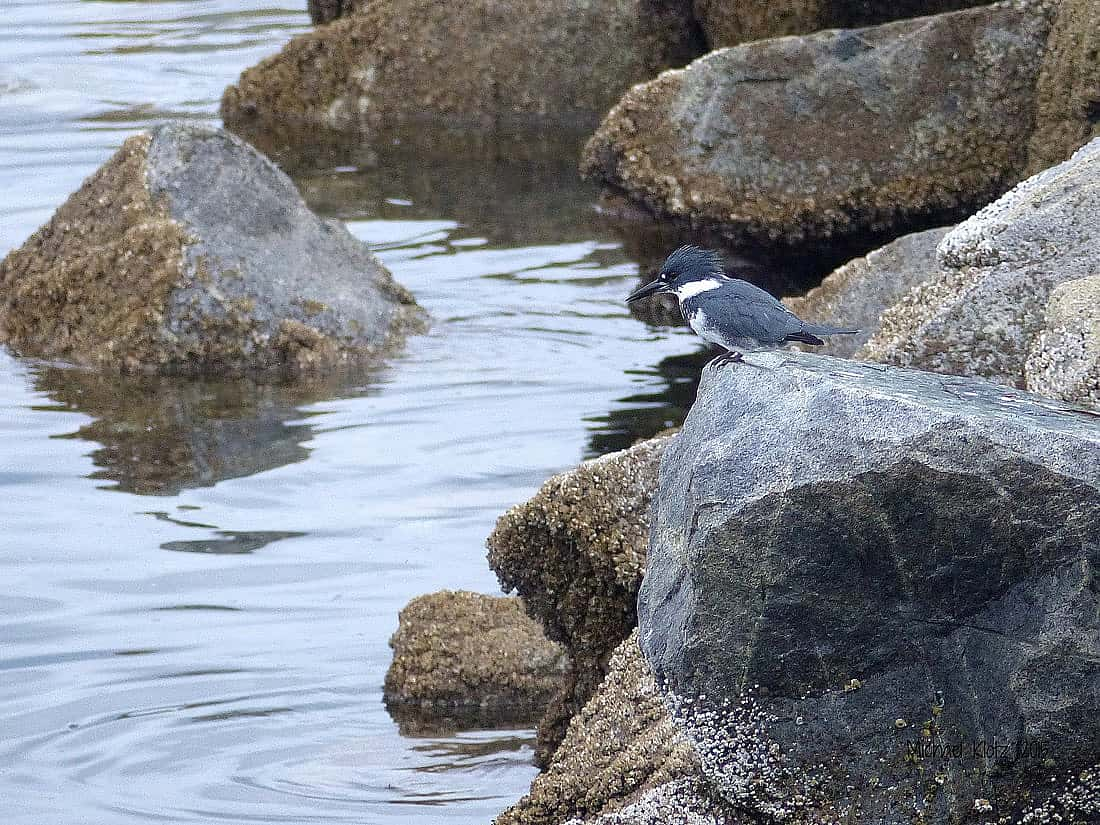
Belted Kingfisher’s Habitat
As previously mentioned, Belted Kingfishers live around water. Examples of their most favored habitats are rivers, streams, ponds, bays, lakes with calm water, and estuaries. You may also be observe them along the coast.
The main requirement is that the water in their chosen habitat needs to be clear for better hunting. Additionally during breeding season there is a need for areas with steep dirt or sand banks for nesting.
Along with these, Belted King Fishers also prefer places with very little vegetation that would obstruct their view of the water. However, they also require nearby perches. A high snag, for example would make a suitable perch.
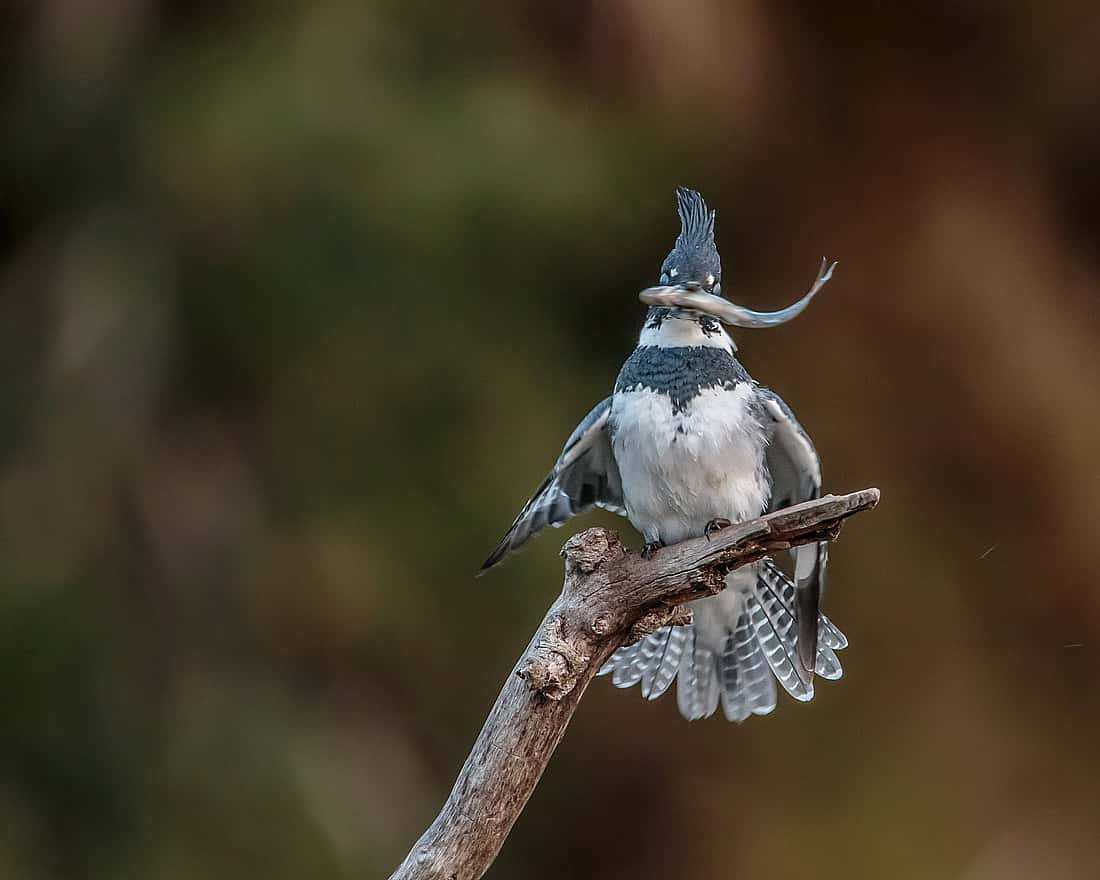
Hunting Behavior and Diet
Belted Kingfishers favorite diet is small fish, usually less than 4-5″ long. Besides these they also feed on crayfish, mollusks, frogs, tadpoles, and aquatic insects.
According to the National Audubon, though far less common, Kingfishers may occasionally capture prey not found in water, such as small mammals, young birds, and lizards. At times they have even be seen eating berries.
These birds depend on sight for hunting, thus leading to the importance of water that is clear enough to allow them to find prey below the surface.
Their typical method of hunting is visually searching from a perch that hangs over the water. Once a Kingfisher observes prey it will dive headfirst into the water, grab the prey in its bill, then carry it back to its perch. Surprisingly Cornell reports this dive is made with closed eyes.
Along with this, Kingfishers are also capable of hovering above the water instead of hunting from a perch.
When prey is caught, Kingfishers will often, though not always, pound the prey against the perch before swallowing it head first.
Have you ever heard of owl pellets? Kingfishers also cough up pellets. These contain the skeletons of fish along with invertebrate shells that their digestion system cannot handle.
Enjoy this short video of a Kingfisher catching and eating a small fish.
https://www.youtube.com/watch?v=pSMLJ5NUfSg
This video demonstrates both stunning and swallowing a larger fish.
https://www.youtube.com/watch?v=iIiHkJOk6A0
Courtship and Defense
Belted Kingfishers do not pair up for life, but are monogamous within each breeding season. Outside of the breeding season they prefer to spend their time alone. As a result a new bonding takes place each year.
As breeding season approaches, it is usually males that establish territories. These territories are typically along the water and are generally about a half a mile long. The pair may select their actual nesting site during courtship.The male often explores the bank with his beak while the female calls to him.
During courtship a male will feed the female he is wooing. Once together they will perform noisy aerial chases.
Both members of the pair will vigorously defend their territory by chasing away approaching trespassers while calling out loudly. Alternately they will fly back and fourth across the water, again screaming out their rattling call.
In addition, when kingfishers are aware of encroaching predators such as hawks, snakes, or some mammals, they may land on a perch and raise their crests while moving their body up and down. Along with this they may spread their wings, raise the patches of white feathers next to their eyes, and scream.
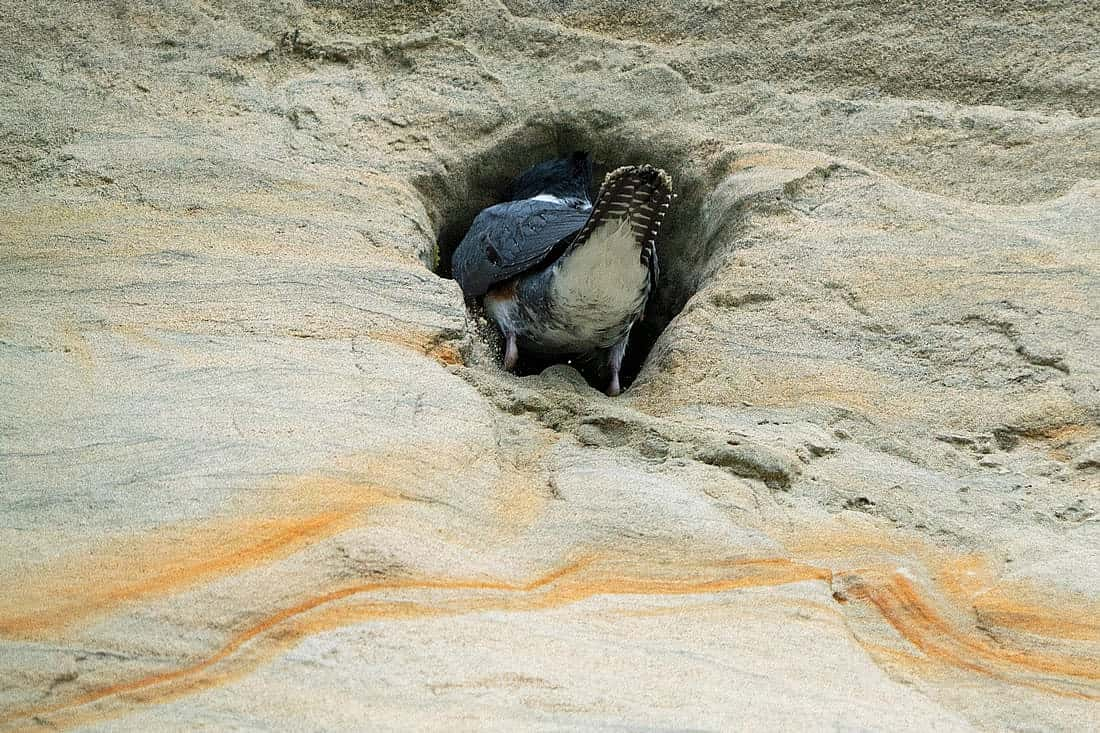
How Kingfishers Dig their Holes
Belted Kingfishers nest at the end of tunnels which they excavate out of a dirt or sandy bank. These are generally high enough to be above floodwaters. Although they commonly dig these along waterways, at times they may also use other banks away from the water’s edge such as ditches, sand pits, road cuts, or landfills.
The birds begin by using their long bills, scooping out the sand and dirt to form a hole in the side of the bank. When the excavation is deep enough one of the birds will enter the hole and begin digging out the hole with its feet, while still using its bill to lengthen the depth. According to the Audubon, the tunnel will generally be three to six feet long. Often the tunnel slopes upward from the entrance. Scientists assume the slope is to help keep water from splashing into the nest chamber.
Both birds take turns in digging the tunnel, although males usually spend twice as much time. Cornell reports that it usually takes 3 to 7 days to complete the tunnel, although sometimes it can take as long as three weeks.
Size of Nesting Hole and Story in Video
The nesting tunnel is only wide enough to admit a single bird at a time. At its end the Kingfishers dig a chamber in which they lay 5 – 8 eggs and raise their chicks. This burrow is approximately 8 – 12 inches in diameter and 6 – 7 inches high. There is no lining added to the chamber, though it will accumulate a layer of undigested fish bones, arthropod exoskeletons, and other items which may add some extra insulation. After the eggs are laid, both parents share in incubating the eggs.
Though the birds do not bond for life, they may, return and reuse the tunnel from year to year. The consequence being that at times they may pair up with the same bird from a previous year. But it is the tunnel, not the mate that calls them back.
Below is the complete nest story in video showing the digging, feeding, and fledgling of a Belted Kingfisher nest.
Kingfisher digging a burrow: https://www.youtube.com/watch?v=hc8B2YgfjWU&list=PLGUpKIsHg7yhjLW1Cz-Nx4rOd72GXTbTq&index=2
Video from outside of a nest burrow with chick feeding: https://www.youtube.com/watch?v=sB8g5himHXw&list=PLGUpKIsHg7yhjLW1Cz-Nx4rOd72GXTbTq
A fledgling leaving the nest–there’s a scary big world out there:
https://www.youtube.com/watch?v=4WoSaZqWti0&list=PLGUpKIsHg7yhjLW1Cz-Nx4rOd72GXTbTq&index=5
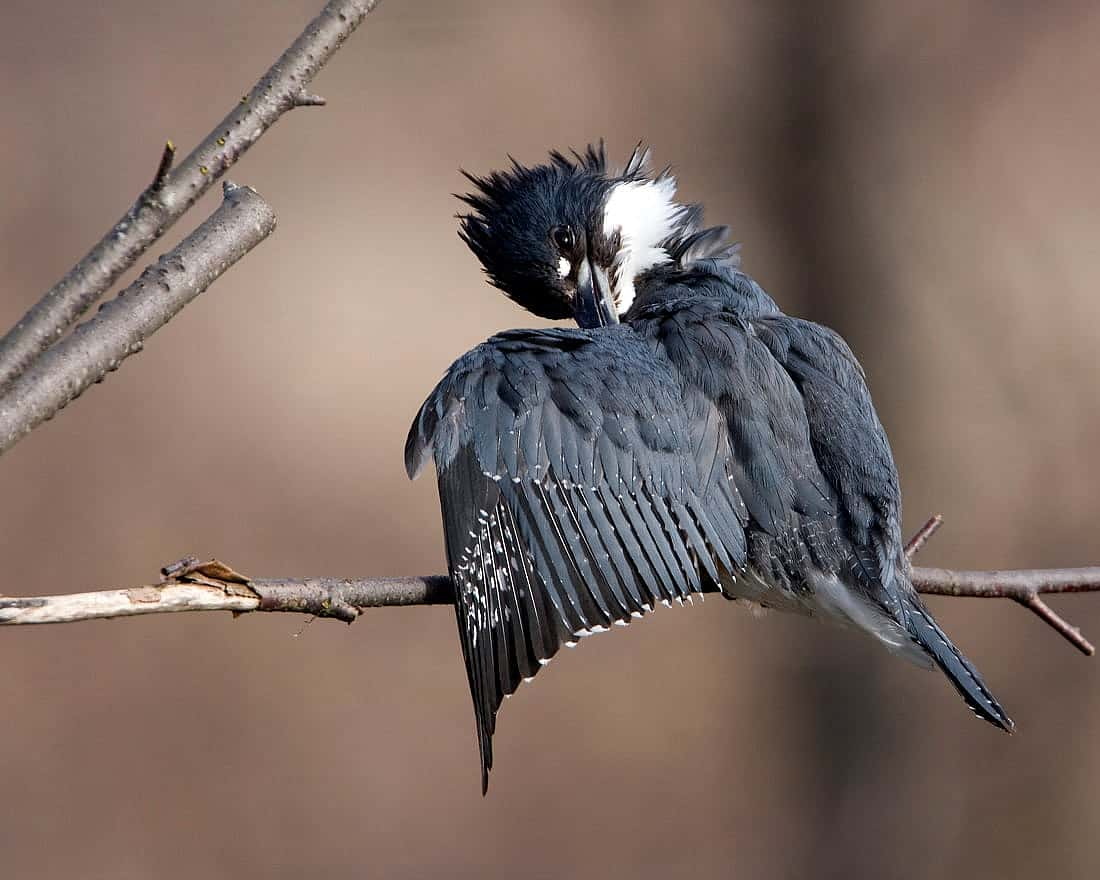
And Lastly
Belted Kingfishers are often heard calling their noisy loud chattering or mechanical rattles in response to even small disturbances. You may often hear them before seeing them. If threatened they may scream. Males will sometimes combine this scream with harsh calls.
To listen to the Belted Kingfisher’s rattle check out these short sound bites:
https://macaulaylibrary.org/asset/129678441
https://macaulaylibrary.org/asset/147239801
Photos:
Opening photo of a Belted Kingfisher perching on tree branch by Andy Reago & Chrissy McClarren, Attribution 2.0 Generic License
Male Belted Kingfisher Yawning by Andy Morffew, Attribution 2.0 Generic License
Female Belted Kingfisher by Jeff Bryant, Attribution-NonCommercial 2.0 Generic License
Belted Kingfisher making his way along rocks in search of dinner, by Michael Klotz, Attribution-NonCommercial 2.0 Generic License
Male kingfisher with a successful catch by Andy Morffew, Attribution 2.0 Generic license
Male and Female Kingfishers perching in a tree in Big Met Golfcourse, Cleveland, by Jen Goellnitz, Attribution-NonCommercial 2.0 Generic License
Belted Kingfisher Entering a Nesting hole, by Marneejill, Attribution-ShareAlike 2.0 Generic License. This license allows for modification. The photo has been cropped to make it compatible with the blog format.
Male kingfisher coming out of nesting hole, by Tom Murray, Attribution-NonCommercial 2.0 Generic license
Belted Kingfisher Preening by Rick Leche, Attribution-NonCommercial-NoDerivs 2.0 Generic License
Written By
Anne Hay
Anne Hay has a Bachelor's degree in Elementary Education and a Master's in Computers in Education. She spent most of her working years teaching third grade at Livingston School in Cody, Wyoming. After retiring she began doing a variety of volunteer work for the Buffalo Bill Center of the West’s Draper Natural History Museum. Anne loves nature and has a concern for the environment. She believes that educating the public, so that they will have a better understanding and appreciation for the natural world, is very important. Because of this belief, volunteering at the Center is a perfect fit. She spends time in the Draper Lab, observing eagle nests for Dr. Charles Preston’s long-term research project on nesting golden eagles, writing observation reports of raptor sightings in the Bighorn Basin, and working with the Draper Museum Raptor Experience. Anne states that, “Having a bird on my glove, is one of my all time favorite things in life.”

